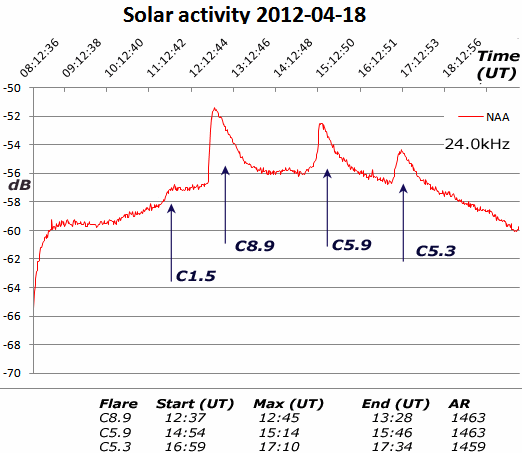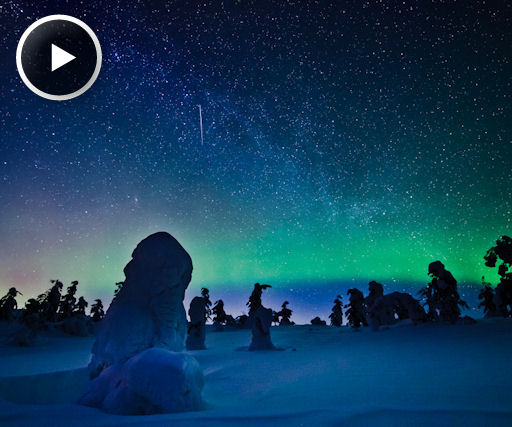UNUSUAL 3D METEOR PHOTO-OP: This weekend, NASA scientists, amateur astronomers, and an astronaut on board the International Space Station will attempt the first-ever 3D photography of meteors from Earth and space. The rare photo-op occurs during the peak of the Lyrid meteor shower. Get the full story from Science@NASA.
ION WAVES IN EARTH'S ATMOSPHERE: Today, a volley of C-class solar flares sent waves of ionization rippling through the atmosphere high over Europe. Dave Gradwell of Birr, Ireland, detected the disturbances using a VLF radio monitoring system:
The source of the flares is a sunspot in the sun's southern hemisphere (tentatively numbered AR1463)--one of several active regions popping up around the solar disk. With sunspot numbers on the rise, more flares and ion waves are likely in the days ahead. Stay tuned. Solar flare alerts: text, voice.
AURORA RECAP: As the midnight sun returns to the Arctic, northern sky watchers are looking back on the 2011-2012 aurora season with pleasure. "There has definitely been increased activity this season as the solar cycle heads toward a maximum in 2013," says photographer Ole C. Salomonsen. "To commemorate the season I have assembled a video from photos I took in northern parts of Norway, Finland and Sweden from fall 2011 to spring 2012." Click to play:
"This video marks the end of a very exciting aurora season for me," says Salomonsen. "It has made me very excited for the upcoming season (autumn 2012), and what it has to offer in terms of celestial lights and experiences!"
This doesn't mean that auroras are gone for everyone. The Arctic Circle may be brightening with summer sunlight, but lower latitudes still have enough darkness for Northern Lights. Indeed, middle-high latitude sky watchers should be alert for auroras on April 20th. NOAA forcasters estimate a 30% chance of geomagnetic storms as Earth enters a region of negative polarity IMF. Aurora alerts: text, voice.

![]()
Solar wind
speed: 326.0 km/sec
density: 0.2 protons/cm3
explanation | more data
Updated: Today at 1656 UT
![]()
X-ray Solar Flares
6-hr max: C7 1126 UT Apr19
24-hr: C7 1126 UT Apr19
explanation | more data
Updated: Today at: 1600 UT
![]()
![]()
![]()
Daily Sun: 19 Apr 12
![]()
![]()
Sunspot 1463 is crackling with C-class solar flares. Credit: SDO/HMI
![]()
![]()
![]()
Sunspot number: 96
What is the sunspot number?
Updated 18 Apr 2012
Spotless Days
Current Stretch: 0 days
2012 total: 0 days (0%)
2011 total: 2 days (<1%)
2010 total: 51 days (14%)
2009 total: 260 days (71%)
Since 2004: 821 days
Typical Solar Min: 486 days
Updated 18 Apr 2012
The Radio Sun
10.7 cm flux: 122 sfu
explanation | more data
Updated 18 Apr 2012
![]()
![]()
![]()
Current Auroral Oval:
![]()
Switch to: Europe, USA, New Zealand, Antarctica
Credit: NOAA/POES
![]()
![]()
![]()
Planetary K-index
Now: Kp= 1 quiet
24-hr max: Kp= 2 quiet
explanation | more data
![]()
Interplanetary Mag. Field
Btotal: 2.3 nT
Bz: 1.3 nT north
explanation | more data
Updated: Today at 1647 UT
![]()
![]()
![]()
Coronal Holes: 19 Apr 12
![]()
![]()
There are no large coronal holes on tthe Earthside of the sun. Credit: SDO/AIA.






